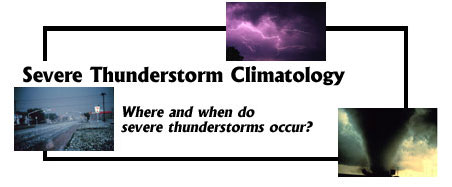Ideas for Teaching
How Often Will Severe Weather Occur Near Me?
Page 1 | Page 2 | Page 3 | Page 4
Introduction
Do you know what your risk from severe weather really is? On one hand, you may recall severe weather warnings for your area a few times a year, but on the other hand, you may not have seen any severe weather at your home in a long time, if ever. Tornado alley has started to gain a reputation as being a place where tornadoes skip across the plains often. It's easy to gain that impression from watching science shows on TV, but it probably isn't very accurate. Your own risk, wherever you are, may be higher - or lower - than you think.
 Tornadoes
and other kinds of severe weather are rare events, making reliable statistics
difficult (we'll talk more about that in another, higher-level section).
If you take severe weather reports too literally you could easily draw
a bad conclusion. So one of the scientists at the NOAA National Severe
Storms Lab used very conservative methods to calculate the risk for thunderstorm
winds, hail, and tornadoes nationwide. He knew which years of data were
most reliable for different kinds of weather reports and you may notice
that in the maps we look at.
Tornadoes
and other kinds of severe weather are rare events, making reliable statistics
difficult (we'll talk more about that in another, higher-level section).
If you take severe weather reports too literally you could easily draw
a bad conclusion. So one of the scientists at the NOAA National Severe
Storms Lab used very conservative methods to calculate the risk for thunderstorm
winds, hail, and tornadoes nationwide. He knew which years of data were
most reliable for different kinds of weather reports and you may notice
that in the maps we look at.
One problem with severe weather reports is that severe weather is generally only reported where people are there to see it. Not surprising, but that means no one really knows how often severe weather occurs where population density is low. Severe weather is often very localized. In fact, the average tornado lasts only 7 minutes. Many are shorter-lived and may occur over open land, never hitting a man-made structure.
So, what did our scientist come up with? On to page 2...
(By the way, if you are not familiar with the Fujita scale, take minute to learn about it before going on. My favorite site for learning about the Fujita Scale is the Tornado Project, a site created by a former teacher and one of NSTA's SciLinks. Click on "The Fujita Scale.")
Last updated: March
25, 2002
Created by: DSZ